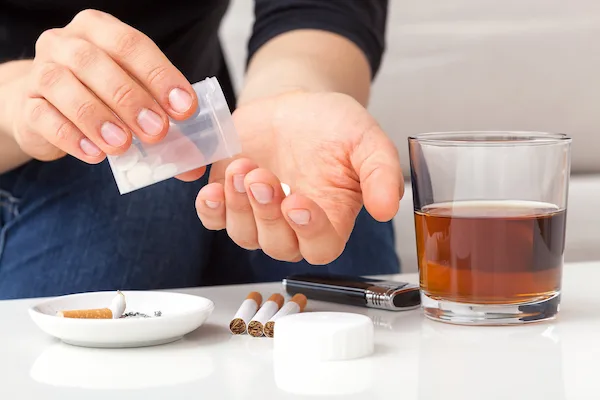Recent data shows that more than 9.2 million people over the age of 12 misused substances in 2021.
Drug exposure to children and adults can have lifelong effects and put people’s health at risk. Understanding the types of drugs can help you make smart decisions and avoid dangerous substances. Although sobriety is the best way to protect yourself, knowledge can also be of use.
If you want to learn about the types of addiction, you must understand the most potent substances. Keep reading to discover what are the most addictive drugs.
Alcohol
One of the most addictive drugs is also one of the most accessible products in the US.
Alcohol is sold on almost every corner and contributes to a major portion of addictions in the country. Some people don’t view alcohol as a drug, however, it is a toxin that poisons the body and produces adverse effects. Drinking is often overlooked, especially if people only associate it with social events.
Regularly drinking alcohol can damage your liver and other organs. Drinking can numb negative feelings and pain, which is why so many people continue to consume it. If you rely on “liquid courage,” you might want to gain insight into your drinking habits.
AA and other organizations are available to help people overcome this addiction. Depending on genetics, some are more at risk of building a dependence than others.
Xanax
If you’ve ever dealt with anxiety, you may have taken Xanax to manage your symptoms.
Small doses taken in severe situations are acceptable, but this drug is highly addictive. Xanax (Alprazolam) is a type of Benzodiazepine prescribed to people with anxiety and sleeping disorders. This drug slows down brain activity, to make people feel calm in a moment of stress.
The sedative and soothing effects make it desirable for people trying to distract themselves. Even if you have a prescription, taking this drug often will lead to uncomfortable withdrawal symptoms. Once people start feeling these symptoms, they often go back to the drug and fall into a cycle of addiction.
Limit the use of this medication if you have anxiety so your body doesn’t rely on it. Meditation and breathing exercises can help you cope with negative emotions and the unexpected.
Fentanyl
More than 100,000 people in the United States died of fentanyl overdose in 2022.
Fentanyl use has been increasing in the country in recent years, although it’s been used in medical settings for longer. Fentanyl is a specific type of opioid that reduces pain levels. The drug disrupts the signal from the spine and brain so that users don’t feel discomfort.
Since fentanyl reduces pain, many people become addicted to it. Misuse is common after surgeries and injuries, where patients are prescribed the medication. Unfortunately, once the bottle gets low, many people search for it in other ways.
This is one of the most addictive and dangerous drugs getting passed around. It doesn’t take much to overdose on fentanyl, even trace amounts found in other substances have killed people.
Sleeping Medications
A common thing that medical professionals notice is that people don’t consider sleeping meds to be addictive.
Lunesta, Sonata, and Ambien are well-known brands of sleeping medications that often get misused. After taking these pills for a while, your body won’t naturally produce the hormones that make you tired. Natural remedies are better for your body and brain, and they won’t disrupt your circadian rhythm.
People diagnosed with insomnia, anxiety, and depression are often prescribed these medications. If you start taking these to get sleep at night, you’ll have to taper off your use. Suddenly stopping these medications could increase the severity of withdrawal symptoms and anxiety.
Heroin
Heroin is a dangerous type of narcotic that can relieve pain but also create an addiction problem.
This drug comes from the opium poppy flowers grown in Mexico, South America, and Asia. The drug typically comes in the form of white powder, often mistaken for cocaine. When it isn’t pure, like black tar heroin, it has a dark brown and sticky appearance.
High addiction rates prevent heroin from being legal in medical settings. Codeine and morphine aren’t as powerful or harmful as heroin, so they can still get prescribed. After stopping use, people typically feel drowsy and nauseous.
What makes heroin a greater threat is that it is normally taken with a needle. These needles, when shared, can infect users with several forms of hepatitis or AIDs. Aside from the damage to your body and brain, overdosing can stop a person from breathing and result in death.
Phenobarbital
Barbiturates are one of the most addictive types of drugs and they are often used to treat sleep disorders and seizures.
There are many health risks and side effects attached to this drug. Although Phenobarbital was commonly used in the early 1900s, it isn’t as popular today. Newer medications can improve symptoms of insomnia and seizures without all of the dangerous risks.
This drug might not be as popular, but it’s still found on the streets. People may get prescribed this drug to help with migraines. Misuse and overdosing can become lethal if patients aren’t careful.
Phenobarbital is a controlled substance that requires a doctor’s visit for a referral. This drug may negatively interact with vitamins and medications, so you need to talk to a doctor first.
Adderall & Vyvanse
Some stimulants aren’t taken by people living on the streets.
Adderall and Vyvanse are often misused by high school and college students. Adults can also become dependent on these drugs in an attempt to manage work or developmental disorders. With so many people diagnosed with ADD and ADHD, it’s difficult to keep these medications off the streets.
The drug produces “feel-good” hormones that make it difficult to stop use. People also feel like they accomplish more when they take them, although it’s likely because of the lack of sleep they are getting. If you’re having difficulty sleeping or managing anger, you may want to assess your stimulant use.
Ritalin and Concerta are other forms of stimulants misused for the same reasons mentioned above. Overdosing or becoming dependent on any of these stimulants can put your health at risk over time.
Vicodin
Another opioid that often gets misused is Vicoden.
Vicoden also goes by the name Norco or Hydrocodone. Young adults may get prescribed Vicodin after an injury or getting their molar teeth pulled out. This opioid is effective at relieving pain and discomfort, but sometimes it can mask the symptoms too well.
People are known to injure themselves and others while on Vicodin. Without feeling sensations in the body, your brain won’t receive warnings from your cells. Many people keep taking these pills so they can avoid emotional and physical pain, but it doesn’t cure the issue.
Weightloss Substances
Social media, photo filters, and advertisements set a high standard for both men and women.
It’s not uncommon for people to feel so much pressure that they ingest supplements that aren’t safe. Weightloss supplements are a type of legal drug that isn’t regulated in the United States. These supplements are made with herbs and fruits associated with weight loss, but the labels aren’t always reliable.
Caffeine and other stimulants are often found in these pills and people become at risk of addiction. Not only do they fulfill the reward center in their brains with a jolt of energy, but these substances also impact people’s appearances. Efforts to lose weight can hinder judgment and put you at risk of overdosing and increasing your vitals.
Valium
Valium (Diazepam) is a type of Benzodiazepine that is prescribed to people with anxiety and sleeping problems.
The calming and sedative effects of this drug make it difficult for users to stop taking it. It has a very strong potential for addiction, even after minimal use. If you’re prescribed this medication, you don’t want to take it daily since it can damage your liver, brain, and heart.
Memory and judgment issues can indicate if someone is misusing this drug. When they consume Valium, their cognition is altered and negative signals are blocked from the brain. Pay attention to your body if you need to take Valium for your anxiety, insomnia, or muscle spasms.
Cocaine
Unless a person’s brain and behaviors alter, they aren’t considered to have an addiction.
Cocaine addiction is quite common since users typically can’t control themselves. The drug is known to produce a positive high due to its ability to alter information in the brain. When people use cocaine they damage their brain and functioning can become impaired over time.
Chronic use and dependency are difficult to overcome because of powerful withdrawal symptoms. Although this drug is naturally found in South America, in the coca plant, it shouldn’t be consumed. If you’re trying to identify cocaine, look for a white powder or a rock form (crack).
The effects of cocaine can feel positive, but they don’t last long. The short high makes this drug highly sought after and is sometimes considered the “rich man’s drug.” Binging cocaine is common as people save up for doses, but the high costs often result in withdrawal.
Meth
Man-made drugs are dangerous and lethal, especially when someone takes more than they anticipated.
Meth is a popular man-made drug that’s created in laboratories. The product is a powder or crystal form, which can be hard to differentiate from other drugs. Never smell, taste, or directly touch white substances, meth can get confused with fentanyl.
Although men are often associated with meth use, women are also at risk. Detox programs save women’s lives and help them process deeper trauma. By getting to the root of the addiction, people can resolve their issues and avoid their need to disconnect.
The psychotic effects of meth can alter thoughts and behaviors. It’s common for people to act aggressively or unpredictably. Although this drug can improve sleep, anxiety, and appetite problems, the risks aren’t worth the reward.
Nicotine
It might not lead to a fast death, but nicotine is still a drug that damages the brain and body.
Many people consume nicotine through cigarettes, vapes, or chewing tobacco. Nicotine is a popular drug that’s legal once you reach the age to purchase the products. This drug is a stimulant that can give people a jolt of energy and induce happy hormones.
The convenience of smoking, especially vapes, makes this one of the most abused drugs in the country. Excessive nicotine use can damage the lungs, tastebuds, and sinuses. Some people have even developed various forms of cancer due to the other ingredients in these items.
Ecstasy
MDMA drugs are typically associated with the party scene.
These drugs are stimulants and hallucinogenic. The high that users experience is short and strong, and the withdrawal is just as powerful. People often take ecstasy when they want to stay up all night and go clubbing or have a hallucination.
To enhance the high, people consume more than what is safe and put their health at risk. Distorted and imaginative visions can put a person’s life at risk and everyone around them. Another reason this drug is so addictive is that it disrupts signals to the brain, you may think you skipped a dose when you just took more.
What Are the Most Addictive Drugs Doing to Society?
Identifying what are the most addictive drugs will depend on the person using them and their habits.
Each drug has unique effects on the body and some people respond worse than others. Short and long-term exposure to these drugs can make it difficult to maintain a job and relationships. By getting help and continuing to absorb knowledge, you can stay away from drugs successfully.
To learn more about sobriety and battling addiction, check out our site for the latest resources!
Read Also: Improving Quality of Life: How Heart and Vascular Specialists Are Making a Difference







